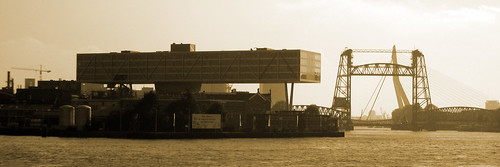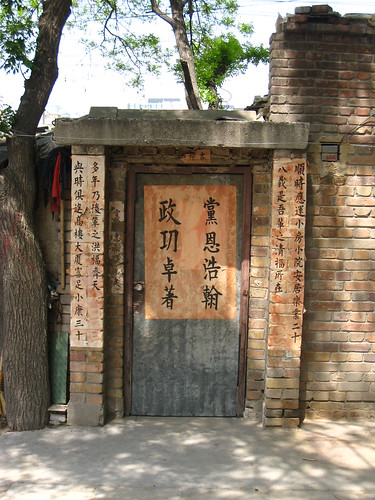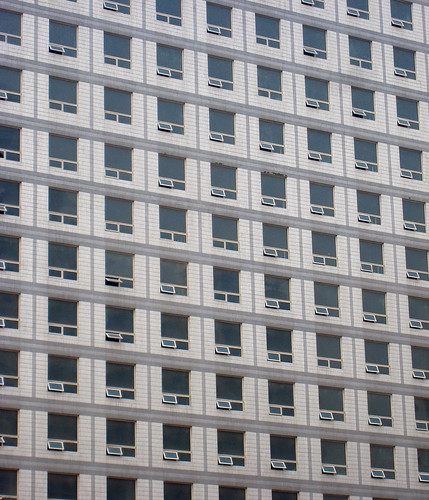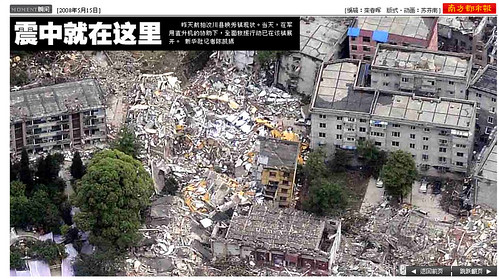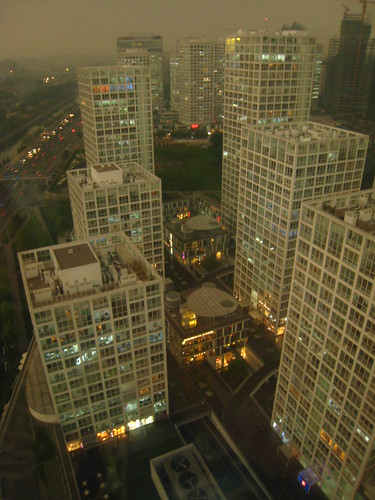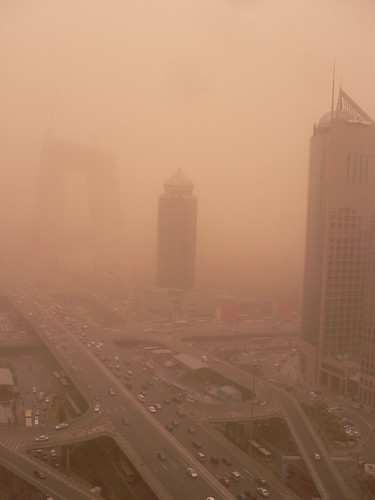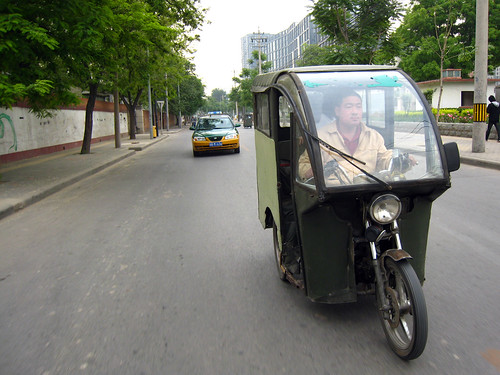Saturday, May 24, 2008
Friday, May 23, 2008
Pic of the Day 24 May 2008
I found this door in an isolated, dilapidated shack next to the train tracks in Beijing a few weeks ago. The owner was chilling a few weeks over to the right.
Thursday, May 22, 2008
Friday, May 16, 2008
Pic of the Day 16 May 2008
This is a satellite view of the destruction from Monday's earthquake in the Sichuan Province of China found here.
Visit the website for an interactive satellite view of the epicenter of the quake.
Thursday, May 15, 2008
Strange Weather

via my flickr page
We are coming ever closer to the future. One day we might reach it. Or maybe we have. The future is now. Rainmaking used to be the stuff of myth and legend. Traveling showmen used to claim they could make it rain in the old days of the US before the practice reached its peak during the Dust Bowl period of the 1930s. Ancient tribes used to perform rain dances. Today, in Beijing, people shoot rockets into the sky and down come the rains.
"Artificial precipitation operations” (aka cloud-seeding)are performed in which a strange concoction of silver iodine, liquid nitrogen and other seeding agents are shot into nascent rain clouds, triggering rainfall. This technique was developed in the 1940’s and used by the US military in the Vietnam War to slow down Vietnamese military trucks during "Operation Popeye.” It has apparently been used for decades in China but the pace is picking up in order to clean the skies for the Olympics. It has definitely been raining more than usual these last few weeks. Most of it, I assume, is “rocket rain”, as I like to call the synthetic stuff.
 Beijing Rain Artillery
Beijing Rain Artillery
If that is not enough, government officials are planning a “cloud busting” operation in order to prevent rain from occurring during the opening day ceremonies. The first cloudbusters were invented by Austrian psychoanalyst Wilhelm Reich. He called it an “Orgone shooter” and it manipulated cosmic orgone energy which was supposed to make clouds produce rain and dissipate. I guess this is how meteorology got its libido back.

Reich and his "Cloud Buster"
For Beijing, meteorologists are currently predicting a 47% chance of rain, according to Urbane, a free-monthly newsletter in Beijing. Hmmm…50-50 chance. I could have predicted that also. Right now “100 people and three aircraft will be ready to manipulate the weather” during the Olympics. According to Zhang Qiang, head of the city’s weather modification office, “Preventing heavy rain is very difficult.” You think??
rocket rain acid rain tornado rain earthquake rain sandstorm rain cyclone hurricane freezing rain snow sleet drizzle hail convection rain purple rain
From what I have experienced in Beijing the last few months, sandstorms, earthquakes, and rocket rain all start the same way: the sky turns a strange pinkish-orange color, the wind becomes ferocious, lightning and thunder pick up, and at that point anything can happen. Yesterday a strange rain came upon us late in the afternoon, prompting an email conversation between me and my girlfriend that went a little something like this:
Me: that's really cool! I forwarded it to my teammates. it is looking scarier and scarier these last few minutes—I think they are shooting rockets again.
Her: I doubt. It maybe the signs of earthquake!
Me: I know, but let's just hope they are rockets, it is safer for us, at least in the short term.
Her: Babe, do you think I should go home after work or stay in SOHO
Me: I think it is safe to go home, but do what you think you need to do. Are there any warnings about earthquakes yet? I personally think it is rocket rain.
Her: Hmm, ok.

Rescue operation in Sichuan Province after Monday's earthquake, via NYT
It’s easy to become very glum about the situation. As I was thinking about it this afternoon, I was reminded of Philip K. Dick’s groundbreaking cyberpunk novel Do Androids Dream of Electronic Sheep, the inspiration for the movie Blade Runner. In Dick’s dystopian vision of the future daily radioactive fallout has forced mankind to evacuate Earth and settle on Mars. The first sign of the fallout, which appeared like a dense fog, was the extinction of owls and other birds. The humans that remained on Earth ran the risk of becoming “special”—mentally handicapped or impotent—from the radiation. If you were to take a fatalist attitude you might reckon we’ll all end up that way someday—not from the radiation but from the rain. Any chance of rain might send us running to our fallout/bomb/earthquake shelters because we will never know what to expect! The anticipated precipitation could be our salvation or our demise.
Personally, because I’m somewhat utopian, I like to think of an alternative scenario for the future—a more positive scenario: A drought-less future. A verdant future. A future with clean air. Where rockets are used to bring joy, happiness, and good health rather than destruction. Where our motto might be, like the popeye soldiers used to say back in Vietnam, "Make Mud, Not War."
references and links:
http://en.wikipedia.org/wiki/Rainmaking
http://en.wikipedia.org/wiki/Cloud_seeding
http://en.wikipedia.org/wiki/Cloud-buster
http://www.amazon.com/Do-Androids-Dream-Electric-Sheep/dp/0345404475/ref=pd_bbs_4?ie=UTF8&s=books&qid=1210837555&sr=8-4
http://www.philipkdick.com/
http://en.wikipedia.org/wiki/Orgone
http://www.thingsasian.com/stories-photos/2987
Pic of the Day, 14 May 2008
Part of our freaky weather week here in Beijing--this was another rainy afternoon that could have been caused by rockets. hmmm...conspiracy theories anyone?
Tuesday, May 13, 2008
Pic of the Day, 13 May 2008
 via NYT Slideshow
via NYT Slideshowlinks:
New York Times Article
NYT Slideshow
Sunday, May 11, 2008
Pic o' the Day 11 May 2008
I originally thought that this was a sandstorm but it turns out it could be artificially created rain from rockets.
Exit Strategy?
Disneyland’ Comes to Baghdad with Multi-Million Pound Entertainment Park"
US-backed plan sees shiny future for embattled Green Zone,
whose opening line goes a little something like this: “Forget the rocket attacks, concrete blast walls and lack of a sewer system. Now try to imagine luxury hotels, a shopping center and even condos in the heart of Baghdad.”
Now I have to admit I do not know much about the current situation in Iraq, but these plans are troubling for a couple of reasons. First, should the US even be involved in these types of development ventures to begin with? Perhaps we should be finding ways to enable the Iraqis to rebuild their city themselves through financial investment and aid. This seems both overly patronizing and opportunistic (but I guess the entire Iraq war seems that way, huh?). Something made very clear in the Disneyland article when Llewellyn Werner, the chairman of C3, the company developing the new amusement park, states that “Iraq to me is an open field. I have never in my life seen an opportunity with the potential that Iraq has with its skilled workforce and oil reserves.”
 Secondly, it is disgusting to me that the US military’s urban planners are presenting these developer friendly, lack of vision, no talent, utterly banal urban plans as a potential future for Baghdad. If you want to send people an uplifting message about the future of Baghdad couldn’t you at least make it beautiful? I mean, if you are going to completely ignore the fact that this city has been under siege for five years, that there are serious infrastructure and community building issues to deal with, at least try to give them some hope. Instead you have some bad version of Universal City Walk. Heck, I’d love it if they had gotten Jon Jerde to do this plan—at least he would have done something with more vision. Ok, maybe that’s a stretch, but you know what I mean.
Secondly, it is disgusting to me that the US military’s urban planners are presenting these developer friendly, lack of vision, no talent, utterly banal urban plans as a potential future for Baghdad. If you want to send people an uplifting message about the future of Baghdad couldn’t you at least make it beautiful? I mean, if you are going to completely ignore the fact that this city has been under siege for five years, that there are serious infrastructure and community building issues to deal with, at least try to give them some hope. Instead you have some bad version of Universal City Walk. Heck, I’d love it if they had gotten Jon Jerde to do this plan—at least he would have done something with more vision. Ok, maybe that’s a stretch, but you know what I mean.The problem to me, which is something that seems to come up on this page over and over again, I’m realizing, is that the plan does not even remotely respond to the problems of post-war inhabitation or Iraq’s traditional urban structure: the traditional forms of public space and the way people use public space. It does not attempt to relate itself to the traditional urban fabric of Baghdad, and it appears to disregard the local climatic and geographic context as well. And while I am not a proponent of mimicking existing conditions and am well aware of both the need and the difficulty of introducing new forms of urbanity in traditional cities, this plan does not seem to address either issue in any seriousness. It looks like an ex-pat friendly bar area for diplomats and their families to hang out in and avoid the reality of Iraq (much like the suburban villa communities we have here in Beijing). If the world really is flattening like Friedman suggests, one-size-fits-all strategies such as this are contributing to the cause.
Another disconcerting issue about the two articles is the constant reference to “influence”: don’t you think the Iraqi’s have had enough of US’ influence at this stage? But Navy Capt. Thomas Karnowski brings up the idea twice in the article on the Green Zone. First he states that "When you have $1 billion hanging out there and 1,000 employees lying around, you kind of want to know who your neighbors are. You want to influence what happens in your neighborhood over time.” Later he brings it up again: "Why do people build fences around their house? The intent is until such time as it's much safer around here, you want to be able to influence what goes on." This comes up again in the Disneyland article when Werner states “The people need this kind of positive influence. It’s going to have a huge psychological impact.” Why do have visions of Iraqis wondering around the Magic Kingdom with glazed eyes in a sugar-coated trance a la Clockwork Orange?
I recently found a very good blog by an Iraqi citizen known as Mohammed sharing his experiences of living in war torn Baghdad. I want to share a quote from Mohammed that sums up what I am trying to say in a much better way than I ever could:
My country is being destroyed in every possible way, corruption is wherever you turn your head, even the land of Iraq is suffering, everything beautiful in Iraq is being killed, Iraq is dying and most of them are watching him struggling death while they say to their selves "no, it's not, everything will be good, the future will be bright and everything will settle, sacrifices must be done…..blah blah blah" what more should we sacrifice? We sacrificed our land and soil, we sacrificed our dignity and we sacrificed our children, men and women, we sacrificed our homes and left it to thugs to steal it while we were forced to live as refugees, now it's the dream and the ultimate wish for the Iraqi to be a refugee in any country, we sacrificed our careers, we sacrificed our professors, scientists and doctors, we sacrificed everything, Iraqis lost everything and till this moment there is no real light at the end of the tunnel.
To end, I think I will finish with a quote from Air Force Lt. Col. Monte Harner about the plan for Baghdad. Although he meant it as a positive affirmation of the military’s proposal, I think it can also be read as a damning critique: "You have to stake a goal in the sand before you can begin to move toward it," he said. "Without a vision of what could be, you're just treading water."
PRC friendly links:
Last of the Iraqis
Disneyland Article
Saturday, May 10, 2008
Pic o' the Day, 10 May 2008
As a follow up to the agroURBanism post I'd like to add that gardens need not only inhabit the horizontal surfaces of our cities anymore! I found this little building at TU Delft last summer--I assume it is some kind of research project in green facades--I'd like to go back and see how much of it has grown in sometime because I can imagine it would be really beautiful.
Friday, May 9, 2008
pic o' the day, 09 May 2008
I'm riding in the back of one of the things in the foreground. It's the fastest way to get to work!
Thursday, May 8, 2008
agroURBanism
First, after a couple of months of being hit over the head by the media I finally got it—we have a world hunger crisis on our hands!! Right now most of you must be thinking “Shit, this guys an idiot, he just figured it out?” I know, I know! I feel like a fool too. But now I am finally on the bandwagon. So, just in case you’re like me and you don’t read the news everyday, or you have trouble putting all the pieces together, let me fill you in.
BACKGROUND - Recent History
Since 2005 global food prices have been rising at alarming rates. According to Newsweek the current crisis is a rise in global food prices caused by “surging demand for agricultural products as an alternative fuel source, the growing food needs of developing countries like China and India, higher transportation costs, droughts and floods.” My first clue was the Wall Street Journal, who ran an article a few weeks ago about rising rice prices in Asia and how the hoarding of rice in places like Indonesia and Thailand are going to make it worse and it might lead to unrest.
The second tip was Josette Sheeran, executive director of the United Nations World Food Program, who made a statement that the US’ interest in developing alternative fuel sources, aka bio-fuels, were depriving less wealthy nations of foodstuffs such as corn (I believe the statistic was something like the amount of corn that it takes to provide one tank of fuel for a car could feed a child for one year, roughly 90 kg). At the time I thought—so what, plant a little more corn—we need to reduce our carbon footprint! The UN’s argument at the time seemed reductive to me—boiling down the world hunger problem as a battle between starvation and the environment (could there not be a third way?), but it does hold some water. It still seems strange to me however, and very scary, that these two monumental global problems—world hunger and climate change—could somehow be at odds with each other.
Finally, today I open up cnn.com to find this: Somalis Riot Over Food Prices. Rioting is occurring because of food prices!! People are going hungry! There is a rice black market! We have to do something about this!!
INTRODUCTION
Luckily, architects, landscape architects, and urbanists have been planning for this type of situation. There have been many proposals in the last couple of years for different types of agricultural based infrastructures that can be integrated into nurban areas, what I am calling AGRO-URBANISM. The impetus for these proposals are manifold and include the concerns previously mentioned as well as issues of sustainability and sustainable development, a re-positioning of the landscape architecture discipline and the rise of the hybrid discipline “landscape urbanism”, and recent trends in architecture focusing on performance-based design which derive inspiration from ecological and biological systems. What I would like to do in this post is to present a compilation of some of the urban farming proposals that I personally find most interesting—it is not intended to be an exhaustive list, just some of “Dave’s Faves”.
I have grouped the following AGRO-URBAN projects into three broad categories based on their general spatial morphology—Horizontal Projects, Vertical Projects, and Mobile projects. For some of the authors of the projects these morphologies represent a strong ideological stance for the particular trajectory that urban farming should take in the future. It is my belief though that the pressures of urban geography, political structure, and modes of living result in such highly diverse contexts that a fully integrated agro-urbanism must exploit the potentialities of each of the three strands and their various sub-types.
Horizontal Projects
In the 90’s projects began to appear that integrated urban and environmental systems. Parc Andre Citroen for example, designed by Clement and Provost, is a large urban park in Paris that exploits the productive nature of agriculture as a medium and fuses it with recreational and educational functions. Two unrealized projects that are very interesting to look at are Agronica by Andrea Branzi and City Fruitful by Kuiper Campagnos and Oosterhuis.
Agronica (1994), and its follow up project for Strijps Phillips in Eindhoven (1999), is the result of the evolution of Branzi’s theoretical research into flexible urban systems since “No-Stop City” and his collaboration with Archizoom in the 1960’s. Agronica uses industrial production techniques to create a provisional, flexible, low-impact agricultural infrastructure that responds to today’s demands for fluidity and rapid change of use. It is based on a theory Branzi developed called “Weak and Diffuse Modernity” based on the transition from mechanical to digital technologies and new economic systems that demand micro-managed temporary equilibriums rather than definitive, lasting solutions. Agronica can therefore be seen as a transitional project and can take advantage of agriculture’s ameliorative properties to prepare brown field sites for future uses. It should also be pointed out that the Eindhoven project also proposes public transportation infrastructures and recreational uses for the site—including a gigantic roller coaster!

City Fruitful by Oosterhuis, et al., developed out of a particular problem in the Netherlands that most countries do not face—a lack of space for housing due to a highly developed agricultural industry largely using greenhouse and hydroponics technologies. The idea was to integrate agriculture and housing, typically “monoculture environments”, in one urban plan. The resulting design consisted of hybridized greenhouse and residential structures, agriculture public spaces, and the use of heat-exchange for an environmental and economically efficient system. You might say it is an early example of an ecolomical project, to quote a recent buzz-word of both public policy and design.

In general, the Netherlands has produced a model for highly efficient, spatially dense agriculture industry that I think could be a prototype for the rest of the world. The result of the amalgamation of the greenhouses is something I have often thought of as a “farm-city” that can be integrated into urban areas or even into hybrid building types. When I first encountered them last year near Delft I wondered if it could be possible to integrate these structures with other horizontal building types such as parking garages, big box retail, and storage facilities—the detritus result of sprawl and contemporary lifestyles, particularly in the US.
 Photo of greenhouses in The Netherlands, by author.
Photo of greenhouses in The Netherlands, by author.In addition to these large-scale plans it is worth mentioning the rise in popularity of co-op and community gardens worldwide. These grassroots efforts at producing agro-urbanism are great ways of improving the environmental and social sustainability of neighborhoods and cities.
Vertical Projects
Vertical urban farms have become in vogue recently largely through the publicity efforts of Dickson Despommier and his Vertical Farming project. Despommier is a professor at Columbia University and has developed some important articles and projects espousing the virtue of vertical farms. The statistics are quite convincing: if population projections hold true our world will have 8.9 billion inhabitants by 2050, requiring us to increase our current 800 million hectares of agricultural land by 109 hectares-roughly the size of Brazil. The problem is twofold—first, the amount of arable land is limited, and second, cultivating the land for agricultural use destroys eco-systems and reduces bio-diversity, particularly with monoculture farming techniques. Vertical farming is the logical result of these issues—you can grow more crops on less land while also freeing up current agriculture land to return to its natural state. According to Despommier one thirty story vertical farm with the footprint of one city block (roughly 30 mill sq. ft.) could provide enough produce to accommodate the needs of 10,000 people.
A visit to the Vertical Farm website will demonstrate a number of vertical farm designs by practitioners and students alike. To me, the most beautiful of the propositions is the Living Tower by atelier SOA Architectes, perhaps because it is the least high-tech scheme featured on the site (and it has some great graphics!). It is also one of the few hybrid schemes featured, integrating office and residential, and agricultural functions in one building. While this is a provocative idea I wonder if that reduces its feasibility—both from a implementation perspective (what agency or developer would commission such a concoction?) and from a building technology perspective. While these are serious considerations for the future of vertical farming, I do not want to diminish the power of the Living Tower’s design.

No discussion of vertical farming would be complete without bringing up MVRDV's Pig City project. Well, perhaps it would be complete, but it was the project that first introduced me to the notion of vertical farming. Besides it's obvious humor and irony one of the things that is interesting about MVRDV's proposal is that it is one of the few projects that focuses on the production of MEAT instead of vegetables. The carnivore in me just loves that!

Recently Work AC has jumped on the vertical farm bandwagon as well—or perhaps their proposals can be seen as a hybrid of the horizontal and vertical projects as they seem to have married the urban farm to Virilio and Parent’s “function of the oblique” concept. Their competition winning proposal for this summer’s PS1 competition in New York introduces an urban farm as a piece of traditional urban furniture cum infrastructure—a folded surface that acts as stage, seating, canopy, and above all, an agro-urban ground. From the architect’s description: “our project becomes the ‘Urban Farm’ – a magical plot of rural delights inserted within the city grid that resonates with our generations’ preoccupations and hopes for a better and different future. In our post-industrial age of information, customization and individual expression, the most exciting and promising developments are no longer those of mass production but of local interventions.”
 Work AC also revisited this theme when asked by New York magazine to produce a Utopian vision for a site in downtown New York. Their terraced apartment building features rooftop farms and putting greens. What is interesting is that this building is essentially a collapsed version of Abercrombie’s valley section and plays on recent trends of suburbanites moving back to the city and bringing everything with them but the kitchen sink (cuz it’s already there but the golf courses, wal-marts and home depots are not).
Work AC also revisited this theme when asked by New York magazine to produce a Utopian vision for a site in downtown New York. Their terraced apartment building features rooftop farms and putting greens. What is interesting is that this building is essentially a collapsed version of Abercrombie’s valley section and plays on recent trends of suburbanites moving back to the city and bringing everything with them but the kitchen sink (cuz it’s already there but the golf courses, wal-marts and home depots are not).
Mobile Projects
This last category features a series of projects that respond to evolving trends in lifestyle (increasingly nomadic) and tourism (eco-tourism, to be more exact), particularly the increased mobility of the world's population. These projects are highly exploratory even among this collection of speculative proposals, and introduce movement into agroURBanism--either the movement of people in relation to agriculture, or the movement of the ground itself!
The ‘Nomadic Garden” is a transportable garden designed by Nadeau, Dupont-Rougier, and Alexander and exhibited in Paris in 1999. The concept is based on the increasingly mobile lifestyles of the urban dweller whose transient nature does not permit the ability to invest in a garden. The design consists of a stainless steel cube that opens up to reveal four wooden shelves that can be shifted horizontally and vertically to allow a variety of configurations. It utilizes a hydroponics system for growing vegetables, herbs, and flowers and it can also be converted to a small-scale green house. When the owner moves she can simply pack up the box and take it with her.

‘Soil Horizon’ is an art installation by Lateral Architecture that reveals how agro-urbanism can embed eidetic and educational purpose allowing it to transcend the primarily technocratic nature of many urban farming proposals. While not intended as an urban farm as such I think it could become a model for a nomadic farming similar to the nomadic garden project. Taking inspiration, I think, from Robert Smithson’s non-sites, Soil Horizon is part garden, part art, and part mapping project. It reveals the diverse geographic character of a region—it essentially acts as a lens through which one can view an entire territory. It also demonstrates the fundamental beauty of dirt—something I have been fascinated in since my days of soil judging in 4-H.

Alishan Tourist Routes, by Reiser + Umemoto, while not exactly urban, demonstrates the symbiotic potential of agriculture, tourism, and geography. From the architects’ website: “One degree of latitude = One kilometer of altitude. This is a crucial equation in the understanding of the potential of the Alishan Mountain as a tourist site. It allows both an ecological and cultural connection between Taiwan and a family of nations via a material argument about culture in the new global society: that new regionalisms can be constructed at all levels of material practice. We propose transforming the Alishan railroad right-of-way into an agricultural strip, supplying a series of specialty restaurants and a microeconomy of taste tourism…Agriculture maintains a varied and dynamic landscape of extreme variance. A Journey up the Alishan Mountain is a journey through four distinct ecosystems. We propose to harness this difference and accentuate it, so that the different climactic regions are reflected in a gradient of culture, cuisine, and landscape along the line. What we are proposing is the development of micro-agriculture to support international cuisine tourism along the Alishan train line.”

-to be continued-
Additonal Links and References:
Hand to Mouth in Newsweek
Global warming rage lets global hunger grow
In hungry world, Japan's farmers stuck with rice found in the Boston Globe, regarding diversifying diets and the demands it makes on Asian agricultural traditions.
Urban Farming
Sky Farming
Next Energy News features an article about a vertical farm in Las Vegas
Sustainable Agriculture from Wikipedia
Urban Agriculture from Wikipedia
Architects and Projects
Eindhoven, un modello di urbanizzazione debole article on Branzi's Eindhoven project
Architettura e agricoltura: article on architecture and agriculture in Italian (I translated it with Google translate)
From Other Blogs:
Tree Hugger
Inhabitat
Wednesday, May 7, 2008
pic o' the day, 07 May 2008
Going to the doctor is not easy feat in China. I felt like a true urban warrior this morning helping my girlfriend go to the dentist this morning. Because public hospitals and dental clinics do not allow reservations or appointments we woke up at 3:30 am to take a taxi halfway across Beijing (from CBD to Peking University), arriving at 5am in order to wait in a queue until 7am when they start giving out numbered tickets to the doctor of your choice. The constituency of the wait room is a strange brew--ticket scalpers, gofers, normal dental patients, and those whose dental hygiene has gotten so out of control as to pose a serious health risk--all a result of the unique political, economic, and social pressures confronting contemporary China. The men shown in the picture are most probably professional reservationists--individuals whose life work is to go from hospital to hospital early enough to grab the prime tickets to later sell to the higher bidder at the end of the line. A number one spot in line can turn a 7 RMB ticket into a 200 RMB cash cow for the right scalper.

